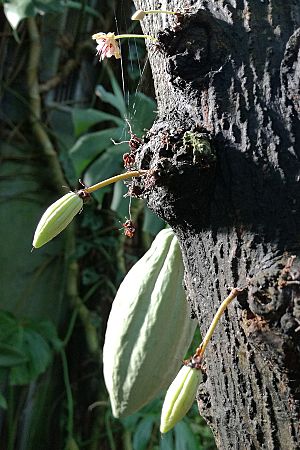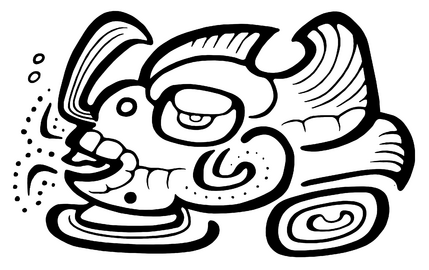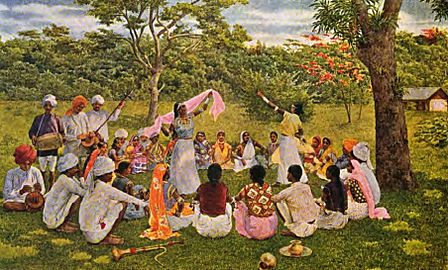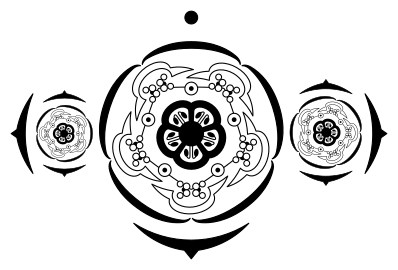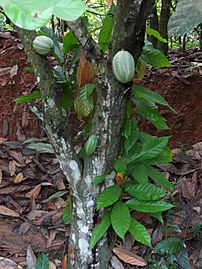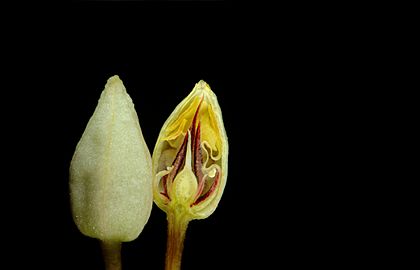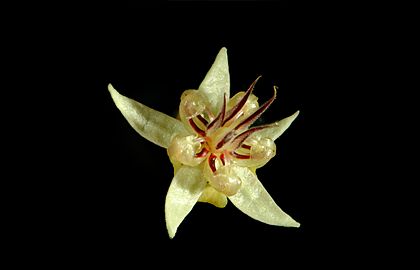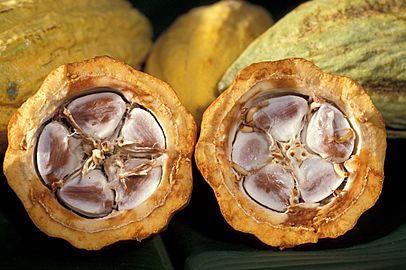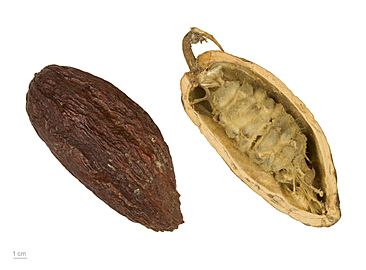Cacao tree facts for kids
Quick facts for kids Cacao tree |
|
|---|---|
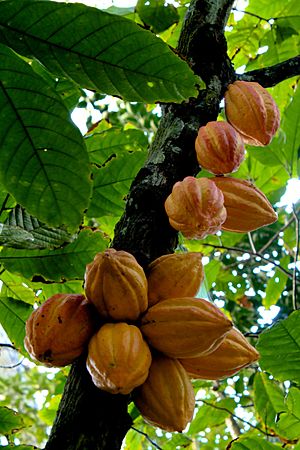 |
|
| Cacao fruits on the tree | |
| Scientific classification | |
| Genus: |
Theobroma
|
| Species: |
cacao
|
| Synonyms | |
|
|
The Cacao tree, scientifically known as Theobroma cacao, is a small evergreen tree that grows in warm, tropical areas. It's most famous because its seeds, called cocoa beans, are the main ingredient used to make chocolate.
Contents
Quick facts
- Scientific Name: Theobroma cacao
- Family: Malvaceae (This is the same family as hibiscus and cotton).
- Size: Usually grows between 6 and 12 meters (about 20 to 39 feet) tall.
- Leaves: Its leaves are large, smooth, and oval-shaped, measuring about 10 to 50 cm (4 to 20 inches) long.
Where does it come from?
The cacao tree originally comes from the tropical parts of the Americas, including areas from southeastern Mexico all the way down to the Amazon rainforest. However, today, the biggest producer of cocoa beans is the Ivory Coast in West Africa. In 2022, the Ivory Coast grew about 38% of the world's cocoa beans. Other big producers include Ghana and Indonesia.
Flowers
Cacao trees have small, pretty flowers that are only about 1 to 2 cm (less than an inch) across. What's cool is that these flowers grow right on the trunk and older branches of the tree, not just on the tips of the branches like many other plants. This is called cauliflory.
These tiny flowers aren't pollinated by bees or butterflies, but by even tinier flies called biting midges. These little insects are super important for helping the cacao tree make fruit.
Fruit
After the flowers are pollinated, the tree grows a fruit called a cacao pod. These pods are shaped like an oval and are quite large, usually 15 to 30 cm (6 to 12 inches) long. When they are ripe, they turn a bright yellow or orange color.
Inside each pod, there are about 20 to 60 seeds, which we call cocoa "beans." These beans are covered in a sweet, white, gooey pulp. The beans are the part used to make chocolate, but the pulp is also tasty and can be used to make things like juice or smoothies in some places. The pulp is said to taste a bit like lychee or tropical melon.
Each cocoa bean contains a good amount of fat, which is what we call cocoa butter. The beans also contain a natural compound called theobromine, which is a mild stimulant, a bit like caffeine.
Name
The scientific name Theobroma cacao has a cool meaning. Theobroma comes from ancient Greek words: theos meaning 'god' or 'divine', and broma meaning 'food'. So, Theobroma means "food of the gods"!
Cacao comes from the names used for the plant by ancient people in Mesoamerica, like the Maya and Aztec. Words like kakaw and cacahuatl were used to describe the tree and its beans. Sometimes people call the tree and its beans 'cocoa' instead of 'cacao', but they are the same thing.
Types
Just like there are different types of apples or oranges, there are different types of cacao beans. Scientists have grouped cacao trees into different categories based on where they come from and what they look like. Some of the main groups include:
- Criollo: These beans are considered very high quality, rare, and expensive. They are less bitter and have a wonderful smell. The ancient Maya used Criollo beans. Only about 10% of chocolate is made from this type.
- Forastero: This is the most common type of cacao bean, used in about 80% of chocolate. Forastero trees are stronger and more resistant to diseases than Criollo trees, which makes their beans less expensive.
- Trinitario: This type is a mix between Criollo and Forastero.
In 2008, researchers looked closely at cacao trees and suggested there are actually 10 main groups based on their genes and where they grow.
Growing cacao
Growing cacao trees takes a lot of work. In 2016, cacao was grown on about 10.2 million hectares (that's over 25 million acres) around the world. Both large farms and millions of small farmers grow cacao.
A cacao tree starts making pods when it's about four or five years old. A single mature tree can have thousands of flowers in a year, but only about 20 of them will turn into pods. It takes about 40 pods (which contain about 1,200 beans) to make 1 kilogram (about 2.2 pounds) of cocoa paste.
After the pods are harvested, the beans are taken out and go through several steps to become chocolate, including fermenting the pulp around the beans, drying, and roasting.
Threats
Cacao trees face challenges from pests, diseases, and even changes in the climate. Scientists and farmers are working together to protect cacao trees and make sure we can keep enjoying chocolate in the future.
- Diseases and pests: Cacao trees can get sick from things like fungi, viruses, and tiny insects. These can cause big problems for farmers and reduce how many beans they can harvest.
- Climate change: Cacao trees need specific warm and humid conditions to grow well. As the climate changes, some areas where cacao is grown might become too hot or dry.
- Conservation Efforts: Scientists are trying to save the different types of cacao trees by keeping collections of them in special gardens called genebanks. This helps breeders create new types of trees that are stronger and can resist diseases or handle different climates. There's a plan called "A Global Strategy for the Conservation and Use of Cacao Genetic Resources" to help make sure cacao diversity is protected for the future.
Genome
Researchers are also using modern science, like studying the tree's DNA (its genome), to understand how to make cacao trees healthier and stronger.
Scientists have mapped out the entire set of instructions (the genome) inside a cacao tree's cells. This is like having a complete blueprint for the tree! The cacao genome has 10 pairs of chromosomes. By studying the genome, scientists can learn which genes help the tree fight off diseases or produce better-tasting beans. This information helps them breed new types of cacao trees that are more resistant to problems and can grow well in different conditions.
History
Cacao trees have been important to people for thousands of years!
Ancient Times
Scientists believe the cacao tree was first used by people at least 5,300 years ago in what is now Ecuador in South America. People there, like the Mayo-Chinchipe culture, likely used the sweet pulp around the beans.
Later, in Mesoamerica (areas like Mexico and Central America), ancient civilizations like the Olmec, Maya, and Aztec also discovered and used cacao. They found ways to prepare the beans to make special drinks. Evidence shows they were using cacao as early as 1900 BC!
These ancient people used cacao drinks for important ceremonies, sometimes for medicine, and also just to enjoy. They often mixed cacao with things like maize (corn), chili peppers, vanilla, and honey.
Cacao beans were so valuable to the Aztec that they even used them as a form of money. Imagine buying things with chocolate beans! A good quality cloth cloak could cost 80-100 beans. The Aztec empire even received thousands of loads of cacao beans as payment from people they ruled.
The Maya and Aztec people also had special beliefs about cacao. They thought it was a gift from their gods. The Maya even had a god just for cacao, and they held festivals to honor him.
Modern History
Europeans first learned about chocolate when Spanish explorers met the Aztec in the early 1500s. The Aztec emperor, Moctezuma, was known to drink large amounts of a cacao beverage.
Cacao beans and the drink were brought back to Spain, and from there, chocolate spread across Europe over the next century. Because people in Europe loved chocolate so much, European countries started growing cacao trees in their colonies in the Americas and Asia to meet the demand.
Today, cacao is grown in many tropical countries around the world, and the process of turning the beans into chocolate has become a huge industry!
Fun facts about cacao trees
- The scientific name Theobroma cacao means "food of the gods."
- Cacao flowers are pollinated by tiny midges, not bees!
- Cacao pods grow directly on the trunk and branches of the tree.
- Ancient civilizations like the Aztec used cacao beans as money.
- It takes about 40 cacao pods to make 1 kilogram of cocoa paste.
Gallery
-
kakaw (cacao) written in the Maya script
-
Immigrant workers from India relaxing on a cacao estate in Trinidad, 1903
See also
 In Spanish: Theobroma cacao para niños
In Spanish: Theobroma cacao para niños
- Ceratonia siliqua, the carob tree
- Kola nut


